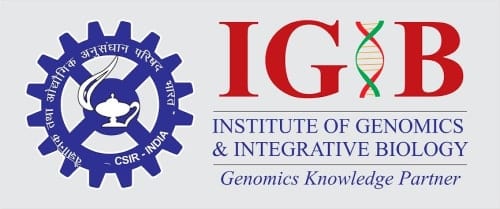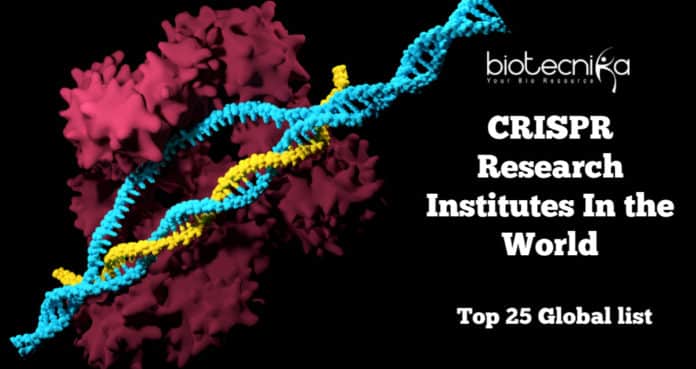CRISPR Research Institutes In the World – Top 25 Global list
In a document, if we suspect a misspelled word, we can use the find function to highlight the error and correct it. In fact, there are many more sophisticated tools nowadays to highlight the wrong letter in a word that might have crept in. Our body is also made of several sequences of letters A T G and C, which define who we become: A Banana or a Human. Funny but the Truth. Now, these sequences can have spelling mistakes, which makes some of us susceptible to something and some of us stronger than others. If this were the 19th Century, we would have just accepted it as our fate, But hey, this is the 21st Century, and the Man has already returned from Moon, So why can’t we edit our own misspelled DNA’s?
Within our DNA, that function is taken on by a system called CRISPR-cas9. CRISPR is a popular way to say Clustered Regularly Interspaced Short Palindromic Repeats. CRISPR consists of two components, i.e, the Cas-9 protein that can cut DNA and a guide RNA that recognizes the DNA sequence to be edited to use CRISPR Cas-9 scientists first identify the sequence of the human genome that’s causing a health problem.
Then they create a specific guide RNA to recognize that particular stretch of A’s T’s GS and C’s in the DNA. The guide RNA is attached to the DNA cutting enzyme cas9 and then this complex is introduced to the target cells. It locates the target letter sequence and cuts the DNA. At that point, scientists can then edit the existing genome by either modifying deleting or inserting new sequences.
It effectively makes CRISPR-Cas9 a cut-and-paste tool for DNA editing. In the future, scientists hope to use CRISPR cas9 to develop critical advances in patient care or even cure lifelong inherited diseases.
But hey, Didn’t we mention that the future is already here? And that means we need to find out where all we have research going on this CRISPR Research technology.
Go through this exhaustive list and we are sure that by the end you will know where your career can reach if you embrace this new technology.
Here we go:
1. Harvard University:
The CRISPR-Cas system has actually become a necessary tool for scientists that intend to 
The group of clinical professionals and scientists at Harvard University’s Wyss Institute for Biologically Inspired Engineering and the Massachusetts Institute of Technology (MIT) in a CRISPR Research showed the benefits of CRISPR Cas9 gene-editing technology as a control component in a new kind of stimuli-responsive smart matter. Upon its activation by specific natural DNA stimuli, a CRISPR-Cas9 enzyme makes it possible for a selection of smart matters to launch bound cargo such as fluorescent dyes and active enzymes. This alters their structures to release encapsulated nanoparticles as well as live cells, or control electrical circuits consequently converting organic into electrical signals.
2. Broad Institute of MIT and Harvard:
Latest in CRISPR Research – Scientists have currently transformed a CRISPR RNA-cutting 
In another research project, a group of scientists from the Massachusetts Institute of Technology as well as Harvard University has deployed CRISPR for an entirely different purpose. The MIT scientists have used the CRISPR Cas9 technology to develop novel materials, such as gels, that can transform their properties when they encounter a particular stretch of DNA. The team of scientists showed they could make use of CRISPR Cas9 gene-editing technology to control electronic circuits & microfluidic tools including release drug delivery, proteins, or living cells from gels. Such materials could be utilized to develop diagnostic tools for diseases such as Ebola or to provide treatments for problems such as irritable bowel disease.
CRISPR Technology Basics Online Certification Course
3. Michigan Medicine – University of Michigan:
A global team of scientists at the University of Michigan has established a new CRISPR-based tool that acts a lot more like a shredder than the conventional scissor-like action of 
4. Duke University:
Scientists consisting of a group of Biomedical Engineers as well as Biotechnologists at Duke 
5. Department of Biosystems Science and Engineering – ETH Zurich:
Scientists have improved the famous CRISPR-Cas system method. For the very first time, researchers have made it possible to customize dozens of genes in a cell simultaneously. This method uses a fairly quick as well as easy manipulate single genes, suggesting they can be precisely deleted, replaced, or modified. Additionally, in the last few years, scientists have actually additionally been utilizing innovations based upon CRISPR-Cas to increase or decrease the activity of individual genes systematically.
6. The University of California – Berkeley:
Scientists did some study on the CRISPR Babies born in China. 6 months ago, Chinese scientists revealed that they had modified the genetic material of 2 babies born last year. The Chinese Scientists used the CRISPR-Cas9 gene-editing technique & changed the CCR5 gene to stop the Human Immunodeficiency Virus from attacking immune cells. A thorough study of the records in the United Kingdom. Biobank shows that having 2 duplicates of this mutation is associated with a 21% chance of mortality in the CRISPR Babies. A genetic variation that Chinese researchers attempted to develop in twin babies to help them safeguard them from HIV infection, is additionally associated with a 21% rise in death in later life, according to an evaluation by the University of California, Berkeley, researchers.
7. The University of California – San Francisco:
Researchers at the University of California, San Francisco discovered a new method that makes use of a unique version of CRISPR gene editing and enhancing to systematically change the activity of human genes in neurons created from stem cells. This is the first 
8. The University of California – San Diego:
Scientists have recently created a new variation of a gene drive that permits the spread of certain, advantageous genetic variations. These variations are known as ‘alleles,’ across a population. The ‘allelic drive’ is used as a guide RNA that helps the CRISPR gene-editing tool to cut the undesirable versions of a gene and also change it with a better version. With 
UC San Diego scientists discovered that phages cooperate to win the fight of time and numbers against CRISPR. To be a reliable immune strategy, CRISPR-containing microorganisms must promptly mount a response to the phage obstacle and it needs to do so prior to the phage eliminates the cell. According to the Scientists The Clustered Regularly Interspaced Short Palindromic Repeats (CRISPR) protein needs to locate the virus’s DNA swiftly. In case the protein fails to do so the virus will proceed and kill the cell.
9. University of Exeter:
A group of scientists at The University of Exeter consisting of Microbiologists & Biotechnologists has discovered that phage particles that infect Pseudomonas aeruginosa can team up together to escape antiviral CRISPR defenses.
10. Institute of Genomics and Integrative Biology (IGIB)
India has also made quite a progress in terms of CRISPR Research. Indian scientists at IGBI have created a brand-new variation of the presently used gene-editing system- CRISPR-Cas9. Researchers have actually shown that this version can boost accuracy in 
11. University of Western Ontario:
Scientists have actually established a new method to deliver the CRISPR-Cas9 DNA-editing tool into microorganisms in the laboratory, finding a method to successfully release a targeted strike on specific bacteria.
12. Emory Health Sciences:
Scientists have actually found that the “scissors” part of the CRISPR-Cas9 system in some cases gets stuck. Max Planck Unit for the Science of Pathogens researchers was also part of 
13. University of Maryland:
The University of Maryland: CRISPR is the ‘molecular scissors’ used to cut as well as modify DNA, however, researchers are currently looking much beyond these applications. Researchers have actually explored the current state of CRISPR in plants, and also just how
14. Tufts University
The scientists of Tufts University have improved the new delivery mechanism system for the CRISPR-Cas9 gene-editing approach in the liver. The distribution mechanism utilizes the 
15. University of Missouri-Columbia:
(Collaborative work with University of Missouri teamed up with researchers from the National Center for Advancing Translational Sciences, Duke University, MU & the National Institutes of Health).
The CRISPR gene-editing strategy is a cutting edge strategy in treating inherited illness. 
16. University of Wisconsin-Madison:
Scientists of the University of Wisconsin repurposed the CRISPR gene-editing tool to examine which genes are in fact being targeted by particular antibiotics. The system has the capability to provide information on how to improve the already existing antibiotics or 
17. InStem Dhan Lab:
They have developed a technology where the Gene editing is attained utilizing the custom-engineered nucleases into cells, in which they develop targeted double-strand breaks at a DNA site of the rate of interest for the objective of creating the insertion/deletion mutations (indels). CRISPR-Cas9 systems have actually been demonstrated to accomplish genome modifying in human induced pluripotent stem cells. Instem Dhan Lab embraces this method to introduce the point mutations in human-caused pluripotent stem cells (iPSCs)newly found cardiomyopathy genetics. The lab differentiated human induced pluripotent stem cells into cardiomyocytes by their recognized protocols. Human cardiomyocytes derived from human induced pluripotent stem cells are used as a tool to understand mechanisms & screening medications.
18. Penn State College of Agricultural Sciences:
Researchers created an innovative technology that is developed to enhance CRISPR-Cas9 
19. Children’s Hospital of Philadelphia:
Using CRISPR gene editing, a research study group from Children’s Hospital of Philadelphia & Penn Medicine have actually thwarted a lethal lung condition in an animal model in which a damaging mutation or variation causes death within hours after the birth. This study, released in Scientific research Translational Medicine, revealed that utero editing could be a promising unique approach for treating lung diseases before birth.
20. The University of Texas at Austin:
A recent study by scientists at the University of Texas has actually clarified the advantages of using Cas12a protein over the standard Cas9 protein in the CRISPR gene editing.The team has discovered conclusive evidence that Cas9 protein, one of the most popular enzymes that are currently utilized for the CRISPR gene editing, is less effective and exact 
21. Cornell University:
CRISPR-Cas3 system research study; A Cornell scientist, that is the leader of the research study in creating a new sort of gene-editing CRISPR system and also his coworkers have used the novel technique for the first time in human cells which is a significant 
22. McGill University:
A collaborative study between scientists at McGill University and the Chinese Academy of Medical Sciences and the University of Montreal in Canada and Peking Union Medical College in China had reported that the CRISPR-Cas9 gene-editing platform may need more 
23. Tokyo University of Science
Scientists at the Tokyo University of Sciences have created a chain of efficient strategies to increase the efficiency of the targeted gene disruption and new gene ‘introduction’ using the CRISPR/Cas9 gene-editing system in the rice blast fungus Pyricularia oryzae.
24. University of Utah
University of Utah scientist has discovered a novel way of using the CRISPR tool. CRISPR was used to reduce chronic pain. This was successfully done by modulating the way genes 
25. George Washington University
Researchers at George Washington University have successfully used the CRISPR-Cas9 gene-editing tool to limit the impact of schistosomiasis and liver fluke infection. These infections affect more than a million people in sub-Saharan Africa, Southeast Asia, and Latin America.
So, here we are with the 25 Global lists of institutes where CRISPR research is being conducted at full throttle. In the above List, CSIR-IGIB & InStem are the two Indian institutes that are making significant contributions in this field. While there are many other prestigious research institutes in India like IIT, IISC, NII, NCCS, IICB and many more where CRISPR research projects are being carried out.
CRISPR Cas9 though has shown some promising results lately which can turn around the table entirely for our researchers enabling them to formulate solutions aiding humanity in terms of disease treatment, food shortage and much more, it’s still in its adolescence stage. Regulatory & ethical hurdles keep appearing now & then, which has to be addressed. Yet no doubt, CRISPR is a technology which in near future will be adapted globally looking to its diverse applications.
Author: Ria Roy & Rahul Mishra
































